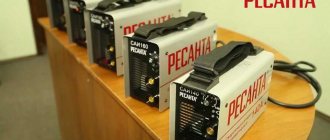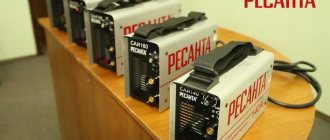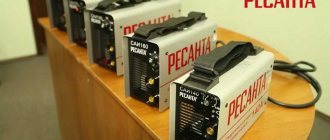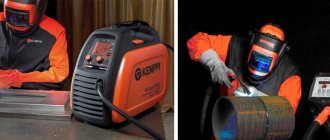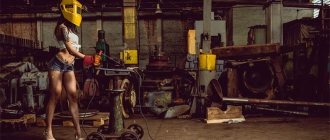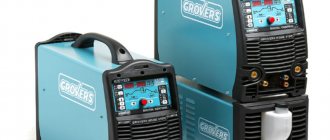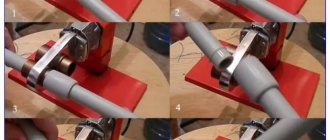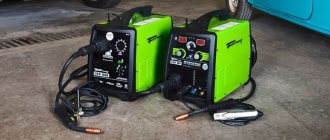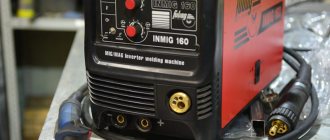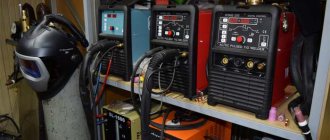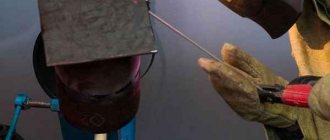Choosing a high-quality and inexpensive unit is not as easy as it might seem. The market is overflowing with offers, and not all types of welding machines are equivalent to each other. Each has features, advantages and disadvantages. You shouldn’t give in to the persuasion of sales managers - it’s better to understand the structure and parameters of welders yourself, then it will be easier to make a choice.
There are 4 types of devices:
- Transformers are inexpensive and simple in design, but heavy and bulky devices. Welding is performed using alternating current. Due to this, only ferrous metals (cast iron, steel) can be welded.
- Rectifiers - also based on a transformer, but welding is carried out using direct current. Due to this, the strength and quality of the connection is higher, and the consumption of materials is lower. Usually used in industry.
- Inverters are compact and lightweight (from 3 kg) devices. The most convenient to use and recommended for beginner welders. They are characterized by a stable arc and can be used for welding non-ferrous metals and thin sheet metal.
- Semi-automatic machines are productive devices that are optimal for long-term operation. Capable of working with all types of metals. Widely used in car repair shops.
Spot welding machine
Due to the pliers protruding from the body, it does not look like a traditional welder. A welding machine is used to perform one operation - welding two thin sheets of steel at one point.
The operating principle is simple:
- the blanks are folded into a bag and secured with a clamp with gaskets;
- selecting a location for the welding point;
- bring the pliers to the point, press with manual force so that reliable electrical contact is ensured between the electrodes and the steel;
- Steel heated by electric current passes into a plastic state and is welded.
The pliers must remain compressed. The device operates from a regular 220 V network and does not require special protective clothing, masks or additives. Welding speed reaches 10 points/min.
Advantages and disadvantages:
High connection speed.
No consumables or welding cable.
There are no emissions of gases or metal vapors.
The body with the pliers has to be kept suspended during operation.
It is not possible to work with all types of steels - mainly black and low-alloy steels are welded.
The tool is specialized, designed for working with sheet metal.
Gas cutting and welding machine
The gas welding installation consists of two high-pressure cylinders, one of which is filled with oxygen, the second with hydrocarbon gas. Previously it was acetylene, now methylene or propane is used. The weight of the cylinders is 10-12 kg. Gas outlets from the cylinders are fed through pressure reducers through hoses to the gas burner, where mixing and combustion of the mixture occurs.
Gas welding is considered the most versatile of all types of welding. It can be used for:
- gas cutting and steel welding. If you have the skills, you can weld both massive parts and thin-walled sheets;
- thermal cleaning and firing of metal surfaces of all types and types of products;
- for heat treatment, heating before hardening, tempering, joining parts by hot fit;
- welding and soldering of small parts with hard solders.
Gas welding does not require connection to an electrical network, but gases will have to be pumped at a specialized station. Refills are inexpensive. Cylinders will need to be pressure tested before filling.
Gas welding is the only type of welding that requires prior training in handling the torch, reducer, valves and cylinders.
Plasma welding
The most modern type of welding technology. The device consists of a block in which a welding inverter and an air compressor are located. The purified air stream, sometimes enriched with water vapor, is fed into a hand burner. Inside the burner device there are two specially shaped electrodes, and an electric arc burns between them. The air flow is heated to the state of plasma and blown through a cooled nozzle onto the surface to be welded.
Plasma can cut all types of materials and weld any metals and alloys. The seam is thin and durable, the quality depends on the correctly selected filler rod.
Plasma welding machines are used mainly for welding thin-sheet stainless steel, cast iron, copper, and precision cutting of sheet blanks.
Advantages of welding inverters
The use of new generation welding equipment makes it possible to improve the quality of welding of metal structures and significantly simplifies the work of both professional welders and craftsmen working at home.
Compared to classic welding equipment, inverter-type semi-automatic welding machines have many advantages. The main ones:
- Compact dimensions and low weight greatly simplify the transportation and storage of welding and make inverters convenient to use.
- It is possible to use direct and alternating current electrodes, which allows you to obtain high-quality seams when working with products made of cast iron, aluminum, stainless steel, and heat-resistant steel grades.
- A large range of control of the input current allows the use of non-consumable electrodes for arc welding under gas protection.
- Availability of additional functions. “Hot start” ensures the supply of current of the optimal value necessary to ignite the electrode. "Anti-Sticking" reduces the current supply to a minimum when a short circuit occurs. “Arc Force” increases the current at the moment of drop separation, preventing sticking.
When choosing welding for home or work in a workshop, you need to focus on the time of continuous operation of the equipment. Professional welding inverters can work up to 8 hours without a break. After half an hour of operation, household-grade equipment will require 30 to 60 minutes to cool down.
Technical characteristics of inverters:
- Power. In the data sheet for the equipment, the manufacturer indicates the rated current value at which the device will not overheat.
- The abbreviation PN denotes the duration of the load, the temporary mode of use of the device.
- The abbreviation DPN denotes the range of supply voltage. It is especially important for welding work in unstable voltage conditions. Power surges of up to 20%-30% most often occur in gardening associations and dacha cooperatives.
- Electrode diameter. The thickness of the metal depends on this indicator, as well as the ability to weld corners or channels. For steel thicknesses from 1.5 to 13 mm, it is recommended to use electrodes with a diameter of 1.6 to 5 mm.
Welding unit (generator)
For work “in the field” in the absence of a stationary electrical network, products that combine several functions are used:
- welding machine;
- electricity generator.
The welding unit consists of:
- internal combustion engine (diesel or gasoline);
- fuel tank;
- generator;
- welding inverter (transformer, rectifier);
- switching and control units.
Fig.9 General view of the generator
The engine produces torque that drives the generator. The latter generates electric current;
- convertible to 220V for connecting other consumers of electrical energy (via a socket on the body);
- supplied to welding equipment to generate the necessary parameters for welding work.
pros
- complete independence from an external power source - the electrical network;
- “2 in 1” function: generating electricity for the welding machine and other consumers;
- financial savings - one unit costs less than two separately;
- The device takes up less space than two separate ones.
The main advantage is its use in places with a complete lack of electricity. This fact is very important for choosing equipment when carrying out repair or construction work in the field.
Selecting a welding machine
In order to weld reinforcement for concrete, build a metal fence, or repair a burst pipe, you will definitely need an electric welding machine. Which welding to choose for home needs?
The main properties of a home welding machine
A home welding machine should be easy to use and safe. Modern welding equipment is small in size and weight compared to Soviet models. Welding machines are easy to transport to the place where welding needs to be done.
Before purchasing, you should decide for what purposes the welding equipment will be used. If the machine is needed for welding plastic pipes, then there is no point in spending money on equipment designed for welding or cutting metal.
To work with welding equipment, a constant, stable voltage is required. However, some models allow you to work with voltages that deviate from the norm by 15%.
Helpful information
Inverter welding machines are widely used in everyday life and in production. Welding will help you weld a gate or barbecue at a dacha, and fasten water pipes or fittings at a construction site.
Inverters are popular because they have many advantages. Small size and weight of the structure. You can easily learn the job. Ability to adjust the welding current from tens to hundreds of amperes. A large model range allows you to easily select household inverters powered from a 220 V network with an electrode diameter from 1.5 to 4 mm or professional welding transformers for 380 V and an electrode from 2 to 6 mm.
Main settings
- Supply voltage 220 or 380 volts, as well as the ability to operate within the permissible range. For example, 160-240 Volts with unstable voltage.
- The power of the inverter affects the maximum thickness of metal that can be welded and electricity consumption. Not all wiring can withstand such power and starting currents must be taken into account.
- The welding current depends on the thickness of the parts being welded and the diameter of the electrode. Selected by maximum value.
- The PN load percentage shows the time intervals between work and rest at maximum current. The higher the value, the longer you can cook without interruption.
- MMA and TIG operating modes. Most often, household DC devices operate using the MMA method - manual arc welding. Most types of metals are welded. Some inverters also weld in TIG mode - manual argon arc welding with tungsten electrodes. Used in welding non-ferrous metals.
Characteristics and descriptions
- Welding current and electrode diameter determine the capabilities of the welding machine to work with metal of different widths. With a maximum current of 200 A, you can work with material no more than 5 mm thick.
- Supply voltage - inverters are divided into those operating in a single-phase or three-phase network.
- Weight of the device - with the same characteristics, a welding inverter from one manufacturer may be lighter than from another.
- The power of the welding machine should be chosen with a reserve for the future, since in the future you may need to weld metal of greater thickness.
Special functions to help you weld
- Arc Force automatically increases the current and reduces the likelihood of sticking when the electrode suddenly approaches the metal surface.
- Hot Start Hot Start provides easy ignition of the arc, which makes it easier to weld with poor electrodes or parts to be joined.
- Anti-stick Antistick is triggered when the electrode touches the part. Automatically reduces the current and prevents the electrode from sticking. If the adhesion is broken, the current is supplied again.
Types, differences, pros and cons
Until recently, the demand for compact transformerless welders was enormous. Certain types of manual welding machines were created at home, and conversion models produced by defense industry enterprises were purchased.
Today the market is oversaturated with offers. The designs of welding machines have become more diverse. But this made the models more advanced. All modern welders are based on the same old circuits, but on a new element base.
By type, devices can be divided into several basic models:
- transformer structures;
- inverter circuits;
- welding machines for DC welding;
- structures for welding in a protective gas environment;
- spot welding devices;
- gas welding units.
All of the above applies only to devices whose circuit and design allow connection to a household power supply of 220 V. This is a basic limitation for all household models.
When choosing the type of welding machine (except gas welding), it is necessary to realistically evaluate the capabilities of the electrical network. Modern semiconductor-based models can work in a country house or in a garage, where the network voltage can be in the range of 150-240V. Older devices with transformer voltage conversion have to be redone.
Transformers
The most ancient type of welder. Actively used for more than a hundred years. The basis of the device is a heavy (up to 20 kg) and powerful (up to 5 kW) transformer, which converts the mains voltage of 220 V at the input into a working alternating voltage of 50-60 V.
For high-quality welding of metal, the transformer must have a certain type of current-voltage characteristic, often steeply falling. A regular power transformer removed from industrial equipment is not suitable for welding.
Before starting work, the welding transformer is adjusted to certain characteristics - current and arc intensity. By moving the ballast resistor or reactor with your hands, it is possible to achieve a steeply falling voltage-current characteristic. This means that from the moment the arc is ignited, the voltage will decrease significantly with increasing current, the amount of energy is released evenly, so there will be no burns or lack of penetration.
Positive sides:
- simple design, easy repair;
- affordable price;
- high welding current – up to 250A;
- reliability.
The service life of a welding transformer wound from high-quality copper wire is 20-25 years. In practice, with careful handling, the service life is limited only by the reliability of the insulation. A wire in proprietary rubber insulation can provide 30-40 years of trouble-free operation.
Disadvantages of the device:
- heavy weight;
- complexity of setup;
- limited use;
- strong interference created by the transformer in the network.
It is not recommended to carry out work using a transformer welder near high-rise buildings in order to avoid conflicts with residents.
Rectifiers
Certain types of materials, such as stainless steel or cast iron, are welded using direct current. For this you need a rectifier. Essentially, this is the same welding transformer, additionally equipped with control systems and a block of semiconductor valves that convert current from alternating to direct. All types of regulators with a transformer are assembled in a compact but heavy housing (10-12 kg).
A control board based on thyristors is used as a mode regulator. With its help you can adjust the current value. The block of rectifying silicon diodes is unregulated. The type of welding current is constant.
Positive and negative sides:
Easy to set up and operate.
Does not require special types of adjustment.
Easy to repair - there are no scarce parts in the thyristor regulator.
Simple types of problems can be easily fixed on your own.
You can only work with direct current, so difficulties may arise when welding thick-walled profiles and certain types of rolled products.
It is difficult to weld thin-walled structures.
The thyristor board has no protection.
For certain types of welding work that require long-term continuous load, instead of a thyristor regulator, a magnetic shunt installed on the secondary winding is used. It is opened or closed using the handle on the front panel of the device.
The unit is considered reliable in operation, but this type of welder is not popular among amateurs due to the difficult selection of operating modes.
Inverters
This type of welding equipment is assembled using electronic components. In the design of the device, voltage conversion is provided by an electronic generator based on controlled switches. There is a transformer, but this type of converter works with high-frequency voltage. Therefore, the weight and dimensions of the device are small. The weight of the inverter rarely exceeds 5 kg.
Inverter welders are assembled on two types of element base - MOSFET transistors and newer IGBT elements. The first type of semiconductors has been produced for more than 50 years; they are distinguished by their reliability and low price. There are about 20 of them in one inverter. They overheat quickly; already at 60 ℃ the protection often trips.
The new IGBTs can withstand temperatures up to 90℃, and an inverter requires up to 10 of them. Such elements are more expensive and do not allow all types of repairs. The size of the semiconductor package is small and it is difficult to desolder it from the board.
All types of inverter welding machines work according to the same scheme:
- alternating current coming from the network, voltage 220 V, is rectified on a block of powerful diodes;
- in the second stage, the filter eliminates interference. At the same time, this type of protection blocks interference from getting back into the network, so you can cook with an inverter even in an apartment;
- after the filter, the generator converts direct current into alternating current with a frequency of about 100 kHz. This makes it possible to use small compact parts and elements;
- the signal from the generator is fed to a high-frequency transformer, where it is reduced to a voltage of 50-60 W, after which it is rectified by high-frequency valves.
In addition to its small size, the welding machine is interesting because of its ability to precisely adjust the current in the electric arc.
Positive sides:
- light weight;
- ability to weld thin-walled parts;
- easy setup;
- no network interference.
Most inverters have additional options that improve the quality of welding by untrained workers. For example, turning on Anti Stick prevents the electrode from sticking when the arc is ignited. The Hot Start system increases the current and voltage at the moment the arc ignites, making it easier to start work.
The negative points are that the inverter requires careful handling. If used incorrectly, the high-frequency generator easily fails. Most types of welder repair require the qualifications of an electronics specialist.
Semi-automatic
A fundamentally new type of welding machine, it has been widely used for decades in industrial production and during repair work in specialized workshops. Semi-automatic welding machines became available with the advent of compact inverters.
The device may have one or two housings. The first block contains an electrical converter, similar to an inverter or rectifier. In the second, there is a reel system for feeding copper-plated welding wire through a flexible rubber sleeve to the welding point. There is a current supply cable inside.
If this is a mobile, portable type of device, then all the elements, except the sleeve, are collected in one block. In addition, CO2 gas is supplied to the sleeve from a cylinder with a gas reducer.
At the end of the hose there is a pistol burner with a button for turning on the gas and wire supply. During operation, the protrusion of the wire electrode is only 4-5 mm, so the welding zone is completely immersed in the flow of shielding gas.
The advantage of the semi-automatic machine is the high quality of the seam. All types of thin sheet steel can be welded.
Despite the fact that, according to statistics, 60% of amateur welding work is performed semi-automatically, the device has many negative aspects:
- consumables - wire and gas of good quality, are not cheap;
- heavy weight of the welding system;
- rapid filling of the workplace with carbon dioxide or carbon monoxide;
- Periodically you need to adjust the operation of the gas valve and wire feed reel.
Of all types of welding work, a semi-automatic machine is justified for car body repairs, the manufacture of large-volume metal tanks, and minor repairs of metal furniture.
Argon arc welding machine
Argon welding differs from other types in that it uses a torch with an argon supply nozzle and a non-consumable tungsten electrode. The remaining elements are made in the same way as those of the semi-automatic device, but without copper-plated wire.
The essence of the argon arc apparatus is to create a soft, stable arc over a weld pool of molten metal. The melting zone is only a few millimeters. Therefore, unlike other types of welding, the seam is thin and uniform, with a small, barely noticeable wave. To compensate for the “sinking” of the seam, a filler material in the form of a rod with alloying additives is added to the bath.
Disadvantages of using argon:
- the cost of argon is an order of magnitude higher than carbon dioxide;
- professional skills in handling argon are required;
- Argon sprayed into the air can cause asphyxiation or lung damage.
Usually the unit is classified as one of the types of welding machines without electrodes, but this is not entirely true. A tungsten rod with a diameter of 2-3 mm burns slowly, but it also needs to be changed periodically.
The advantage of an argon arc welding machine is the ability to weld thin (<1 mm) parts without overheating or deformation of the product. In addition, non-ferrous metals, especially aluminum and copper, are cooked with argon. The strength and tightness of the welded seam is only slightly inferior to the original metal.
The most popular models:
- AURORA PRO OVERMAN 180 Mosfet
- WESTER MMA-VRD 200
- RESANTA SAI 220
Welding machine Eurolux IWM-160
| Welding type | MMA |
| Welding current strength | 10-160 Amps |
| Input voltage | 140-260 V |
| Duration of activation | 70% |
| Electrode diameter | 1.6 – 4 mm |
| Protection class | IP21 |
PROS
- Compactness
- Has a strap for easy carrying
- Shockproof housing
- Does not require special skills to operate
- Hot start - automatically increases the welding current at the beginning of work, making it easier to ignite the arc
- Arc force – prevents sticking of the electrode, reduces metal spatter, and, if necessary, allows for deep penetration of the weld seam
- Anti-sticking - the device automatically reduces the welding current when the electrode gets stuck, making it easier to release it
- Quick connection
- Efficient cooling during operation
- Low price
MINUSES
- Short wires included
- No display
Welding inverter FUBAG IQ 160
| Welding type | MMA |
| Welding current strength | 20-160 Amps |
| Input voltage | 150-240 V |
| Duration of activation | 40% |
| Electrode diameter | 1.6 – 4 mm |
| Protection class | IP21S |
PROS
- Compactness
- Light weight (2.7 kg)
- Smooth adjustment of welding current
- Does not require special skills to operate
- Hot start
- Arc Fast and Furious
- Anti-stick
- Quick connection
- Improved cooling system
- Low price
MINUSES
- Short wires included
- No display
Inverter welding inverter RESANTA SAI 140
| Welding type | MMA |
| Welding current strength | 10-140 Amps |
| Input voltage | 220 V |
| Duration of activation | 70% |
| Electrode diameter | up to 3.2 mm |
| Protection class | IP21 |
PROS
- Compactness
- Light weight (4.3 kg)
- Has a strap for easy carrying
- Stable operation even at high current
- Hot start
- Arc Fast and Furious
- Quick connection
MINUSES
- The protective cover is rattling
- The wires included in the kit are short
Welding inverter FUBAG IN 176
| Welding type | MMA/TIG |
| Welding current strength | 10-160 Amps |
| Input voltage | 230 V |
| Duration of activation | 60% |
| Electrode diameter | 1.6 – 3.2 mm |
| The diameter of the wire | 1.6-4 mm |
| Protection class | IP21 |
PROS
- Compactness
- Multifunctionality
- The digital display and touch controls allow you to instantly set up the machine and control welding parameters without being distracted from your work.
- The electrode selection table is shown on the top panel.
- Stable operation at any voltage
- Hot start
- Anti-stick
- Arc force (only for MMA mode)
MINUSES
- Experience with TIG machines required
Welding inverter BlueWeld Prestige 186 PRO
| Welding type | MMA/TIG |
| Welding current strength | 20 - 160 Amps |
| Input voltage | 190-220 V |
| Duration of activation | 60% |
| Diameter of welding electrodes | 1.6 - 4 mm |
| Protection class | IP23 |
PROS
- Small dimensions
- Stable operation at any voltage
- Hot start
- Anti-stick
- Relatively inexpensive.
- Low power
- Convenient carrying handle
MINUSES
- Experience with TIG machines required
- Not suitable for welding aluminum.
- No argon burner.
Welding inverter Energolux WMI-200
| Welding type | MMA |
| Welding current strength | 10-200 Amps |
| Input voltage | 198-242 V |
| Duration of activation | 70% |
| Electrode diameter | up to 3.2 mm |
| Protection class | IP21 |
PROS
- Compactness
- Has a strap for easy carrying
- Smooth adjustment of welding current
- Hot start
- Arc Fast and Furious
- Anti-stick
MINUSES
- Short wires included
- No display
Rectifiers
Welding rectifiers can be considered an improvement on transformer devices. In welds obtained using rectifiers, those defects that are caused by the use of alternating current are practically eliminated. The devices, in addition to the step-down transformer, have a diode block (rectifier), control, starting and protection elements in their design. Alternating current not only changes voltage, but is also converted to direct current. This makes it possible to obtain an even, stable arc. Accordingly, metal spattering is reduced, and the seam is of higher quality. You can work with any electrodes.
The scope of use of the welder is also expanding - you can join not only low-alloy “ferrous” steels, but also non-ferrous metals, stainless steel, cast iron (using appropriate electrodes). Since direct current has polarity, you should not forget about this - when connecting the electrodes, this parameter should be taken into account. Some welding work is purposefully performed with reverse polarity (aluminium welding).
Many manufacturers today are reducing the production of this type of household appliances. If we talk about professional use, they are still used quite widely . Disadvantages include heavy weight, the need for a qualified welder, and a serious voltage drop in the electrical network during the welding process. Advantages: low price, reliability and good seam quality.
Cost of welding equipment
Prices for welding machines are scattered over a wide range. The cost of the equipment depends on the country of origin, the functionality of the device and the availability of components for it. It is cheaper to buy a welding machine made in China. Japanese welding will cost more, but it may turn out that all the parts were made in China, and only assembly was carried out directly in Japan.
The price increases if the welding has a built-in power factor corrector. Such a device is necessary when the voltage range is too wide: 90–240 Volts.
Prices for welding machines
Welding machine name/Price
| Wert MIG 200 | from RUB 16,395 |
| Resanta SAI-190K 65/36 | from 4,825 rub. |
| Aurora PRO Overman 180 | from RUR 27,625 |
| Solaris MULTIMIG-227 | from 24,000 rub. |
| FUBAG IR 160 31401 | from 5,090 rub. |
Welding machines are divided into several types with their own specifics: welding transformer, rectifier, gas semi-automatic, inverter.
Transformers are the simplest and most inexpensive type of welding machines; moreover, they are reliable and unpretentious in operation. At the same time, the quality of the seam is relatively low, and working with a transformer requires certain skills. Yes, and such devices are suitable exclusively for ferrous metals. Therefore, a welding transformer is best suited for simple work (including at home) and for those who already have experience with welding.
Rectifiers differ from transformers in that they work not with alternating current, but with direct current. This improves the quality of the seam and allows you to weld both ferrous and non-ferrous metals. At the same time, rectifiers are more complex and consume significantly more energy than transformers, which requires appropriate quality electrical networks. Therefore, they are more designed for professional electric welding.
Gas semi-automatic machines are designed for welding in a special gas environment. They are reliable, easy to use and provide high quality welds, especially when welding non-ferrous metals - the gas protects the seam from moisture and oxidation. The disadvantages of semi-automatic machines are their high cost and some difficulties in use (for example, in addition to electrodes, gas mixtures for welding are also required). This type is considered optimal for auto repair shops; it can also be useful for domestic purposes. Inverters are considered the most modern type of welding machines. They provide good weld quality with high productivity, are resistant to low voltage, can weld both ferrous and non-ferrous metals, and are small in size and weight. Their disadvantages are their relatively high cost, as well as sensitivity to voltage surges.
Regardless of the type, when choosing, it is worth considering the voltage for which the device is designed. For domestic use, it is worth taking 220 V devices, and for workshops and production, where high power is required, 380 V models are produced. The main division into household and professional welding machines is based on current strength: devices up to 200 A belong to the first type, more than 200 A - to the second.
It is also worth choosing a device based on current strength depending on the thickness of the metal with which you will have to work. The thicker the metal, the higher the current should be; There are special tables that allow you to accurately select a device for specific needs.
What are the cheapest welding machines?
Top 3 inexpensive products from the Welding machines category:
- ✔ Inverter welding machine Resanta IWM160 Eurolux
- ✔ Inverter welding machine Pobeda AC 200, 200 A
- ✔ Inverter welding machine Resanta IWM190 Eurolux
Device
From a design point of view, they are high-tech systems housed in durable housings. Universal-purpose stations and highly specialized equipment are assembled on the basis of two key components - a generator and an engine. The first component is necessary for generating current, the second is for converting the created energy into power supply.
The ADD welding units also include batteries, a control panel, measuring and control devices, a fuel tank and a rheostat that regulates the current. Equipment packages for some models include mechanisms for drying electrodes, heating concrete or frozen soil, and air plasma cutting units.
All main and additional components are placed on a common metal frame platform and connected using a coupling. To protect the system from mechanical deformation and adverse atmospheric factors, a housing is used. This design allows the welding unit to be used in all climatic zones of Russia and in all weather conditions.
For quick access to the internal structure, special doors (curtains) are provided on the hood. They also make repairs much easier. Some models can be equipped with a spotlight, providing convenient transportation and optimizing operation. All welding machines are conventionally classified into the following types:
- by installation method - stationary and mobile;
- by engine type - diesel, gasoline, electric;
- by generator category - collector and valve.
One of the main advantages of this type of equipment is that working with it does not always require high qualifications. Many manufacturers, when developing autonomous welding units, strive to achieve the ideal balance of solid functionality and the simplest possible operation. This greatly simplifies the choice, allowing you to proceed not from the qualifications of the master, but from the capabilities of the equipment and its cost.
